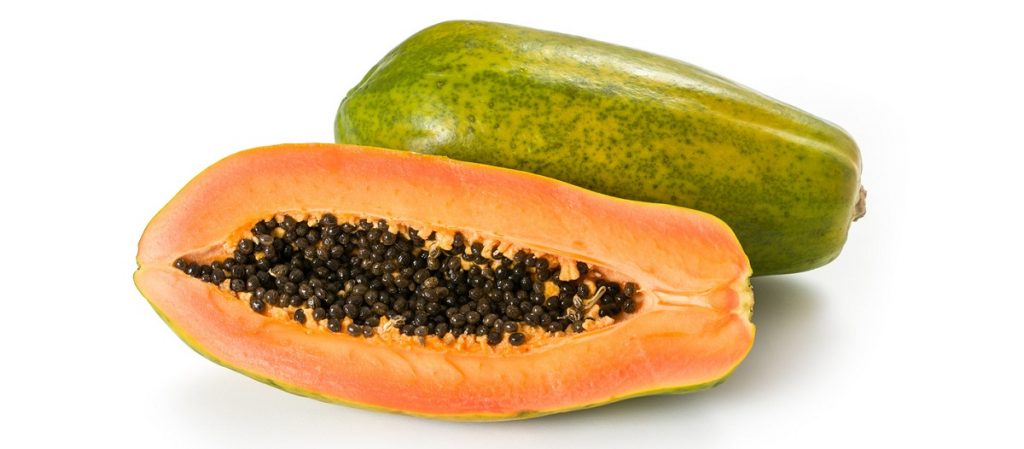A papaya is a cerise-orange colored fruit, incredibly juicy fruit with aroma like its delectable taste in its prime. It’s not only fascinating, aromatic and flamboyant; it is quite healthful as well. papaya or papaw or pawpaw is the plant Carica papaya, one of the 22 accepted species in the genus Carica of the family Caricaceae. Its origin is in the tropics of the Americas, perhaps from southern Mexico and neighboring Central America. In 2017, global production of papayas was 13.2 million tonnes, led by India with 45% of the world total

Fortunately, this glorious fruit is available year-round. Grown in tropics, papaya trees produce fruit all year long. Also they are now produced in Hawaii and Puerto Rico.
Papayas are shaped like elongated melons or enlarged pears. The flesh is sweet and delicious with a aromatic undercurrent, and having a soft melting quality texture. Ripe papaya flesh has a rich orange color with either yellow or pink hues.
Inside, there are black round seeds, enclosed in a gelatinous-like substance. It is believed that these seeds can be used as a black pepper substitute when ground or they have a de-worming significance. Although the seeds are edible, they have a bitter, peppery flavor that few people seem to find enjoyable.
Table of Contents
Papaya Nutritional Information:
A cup of papaya contains 55 calories, 13.7g carbohydrates, 2.5g dietary fiber. Papayas are blessed with vitamin C, folate and potassium. They are also rich in vitamin A, vitamin E, zeaxanthin, leutein and lycopene. Papaya has higher lycopene levels at about 2000ug per 100g.
Also It contains some small amounts of minerals like, calcium, chlorine, iron, phosphorus, potassium, silicon and sodium. The carbohydrate amount in papaya is chiefly of invert sugar used as pre-digested food. The ripe papaya is full of abundance of energy-boosting natural sugars.
Papaya Health Benefits:
- Papaya helps in digestive and heart issues. Externally used in anti-aging products and both the skin and pulp are valuable as healing agents.
- Rare but very valuable is its high arginine, papain and carpain contents.
- Arginine is known to be good for male fertility, while papain is a proteolytic enzyme meaning that it can break down protein, making it usable as a meat tenderizer. Carpain is an enzyme considered to be beneficial for heart.
- Papaya also contains fibrin, a rare product in the plant kingdom. In humans, fibrin is a fundamentall part of the blood clotting process.
However, more study is required, early evidences lead to the belief that papaya may prevent diabetic heart disease. It is high in fiber, which helps to decrease cholesterol. Papaya fiber is an amazing quality to bind cancer causing toxins to it, preventing them from binding to cells in the colon. For individuals with a family history of colon cancer, papaya can become a fantastic dietary addition.
Papaya is a great addition to any meal or snack. Chunks of fresh papaya are terrific in cereal or in smoothies.
How to Eat Papaya
- Place the papaya on a cutting board.
- Using a large, sharp knife cut the papaya in two pieces. If your papaya is ripe, this should be easy to do. Using a large spoon, scrape out the seeds. Don’t cut too deep with your spoon, or you may lose quite a bit of the fruit. You can then enjoy the papaya fruit by digging into it with a spoon or create papaya “mellon balls” with a mellon ball scoop or even an ice cream scoop.
- You can also cut the papaya into slices and use a knife to peel the skin off each slice.
- Now turn the papaya over and simply slice into blocks as you like.